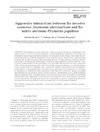Identificador persistente para citar o vincular este elemento:
https://accedacris.ulpgc.es/handle/10553/106283
| Campo DC | Valor | idioma |
|---|---|---|
| dc.contributor.author | Brante, Antonio | en_US |
| dc.contributor.author | Riera, Rodrigo | en_US |
| dc.contributor.author | Riquelme, Pamela | en_US |
| dc.date.accessioned | 2021-03-26T13:34:30Z | - |
| dc.date.available | 2021-03-26T13:34:30Z | - |
| dc.date.issued | 2019 | en_US |
| dc.identifier.issn | 1864-7782 | en_US |
| dc.identifier.uri | https://accedacris.ulpgc.es/handle/10553/106283 | - |
| dc.description.abstract | The distribution range expansion of species mediated by natural or anthropic mechanisms is one of the main causes of changes in biodiversity patterns. Anemonia alicemartinae is a cryptogenic species found along the coasts of the Southeast Pacific Ocean. This species has ex - panded its range by >1900 km along the Chilean coast throughout the last 50 yr. A. alicemartinae co habits with the native anemone Phymactis papillosa in the low intertidal zone, and given the limited mobility of both species, limited space could encourage aggressive behavior between them. P. papillosa shows different color phenotypes, and, as in other anemone species, color is associated with its level of aggressiveness. Here, we evaluated the aggressive behavior of A. alicemartinae on 2 color morphotypes of P. papillosa. Also, intraspecific agonistic interactions were considered in individuals of A. alicemartinae from 2 localities. Four experiments were conducted: (1) individual vs. individual, (2) individual vs. group forming a frontal line, (3) individual vs. group surrounding the individual and (4) group vs. group. Results showed A. alicemartinae to be a weak competitor against P. papillosa. The cryptogenic species lost more contests with green P. papillosa than with the red phenotype. Few aggressive interactions between conspecifics of A. alicemartinae were found. Results suggest that the expansion success of A. alicemartinae could be explained by alternative strategies, such as escape behavior, asexual reproduction and high dispersal potential. | en_US |
| dc.language | eng | en_US |
| dc.relation.ispartof | Aquatic Biology | en_US |
| dc.source | Aquatic biology [ISSN 1864-7782], v. 28, p. 127–136 | en_US |
| dc.subject | 251005 Zoología marina | en_US |
| dc.subject | 2408 Etología | en_US |
| dc.subject.other | Interspecific competition | en_US |
| dc.subject.other | Agonistic behavior | en_US |
| dc.subject.other | Invasion | en_US |
| dc.subject.other | Chilean coast | en_US |
| dc.title | Aggressive interactions between the invasive anemone Anemonia alicemartinae and the native anemone Phymactis papillosa | en_US |
| dc.type | info:eu-repo/semantics/article | en_US |
| dc.type | Article | en_US |
| dc.identifier.doi | 10.3354/ab00718 | en_US |
| dc.contributor.orcid | 0000-0003-1264-1625 | - |
| dc.description.lastpage | 136 | en_US |
| dc.description.firstpage | 127 | en_US |
| dc.relation.volume | 28 | en_US |
| dc.investigacion | Ciencias | en_US |
| dc.type2 | Artículo | en_US |
| dc.identifier.external | 82900332 | - |
| dc.description.numberofpages | 10 | en_US |
| dc.utils.revision | Sí | en_US |
| dc.date.coverdate | Octubre 2019 | en_US |
| dc.identifier.ulpgc | No | en_US |
| dc.contributor.buulpgc | BU-BAS | en_US |
| dc.description.sjr | 0,524 | |
| dc.description.jcr | 1,588 | |
| dc.description.sjrq | Q2 | |
| dc.description.jcrq | Q2 | |
| dc.description.scie | SCIE | |
| item.grantfulltext | open | - |
| item.fulltext | Con texto completo | - |
| crisitem.author.dept | GIR ECOAQUA: Biodiversidad y Conservación | - |
| crisitem.author.dept | IU de Investigación en Acuicultura Sostenible y Ec | - |
| crisitem.author.dept | Departamento de Biología | - |
| crisitem.author.orcid | 0000-0003-1264-1625 | - |
| crisitem.author.parentorg | IU de Investigación en Acuicultura Sostenible y Ec | - |
| crisitem.author.fullName | Riera Elena, Rodrigo | - |
| Colección: | Artículos | |
Citas de WEB OF SCIENCETM
Citations
4
actualizado el 08-jun-2025
Visitas
151
actualizado el 17-may-2025
Descargas
85
actualizado el 17-may-2025
Google ScholarTM
Verifica
Altmetric
Comparte
Exporta metadatos
Los elementos en ULPGC accedaCRIS están protegidos por derechos de autor con todos los derechos reservados, a menos que se indique lo contrario.
